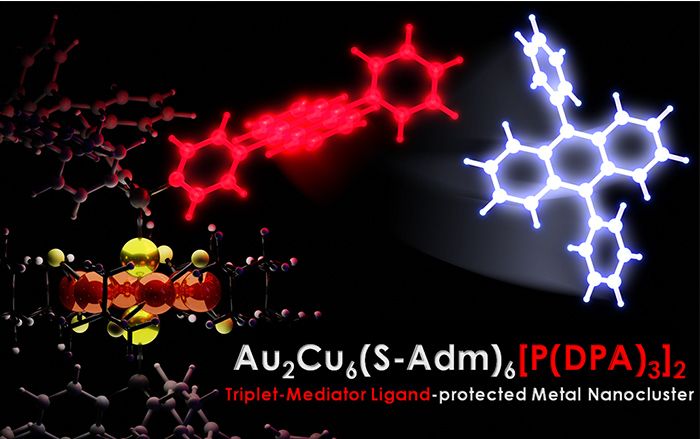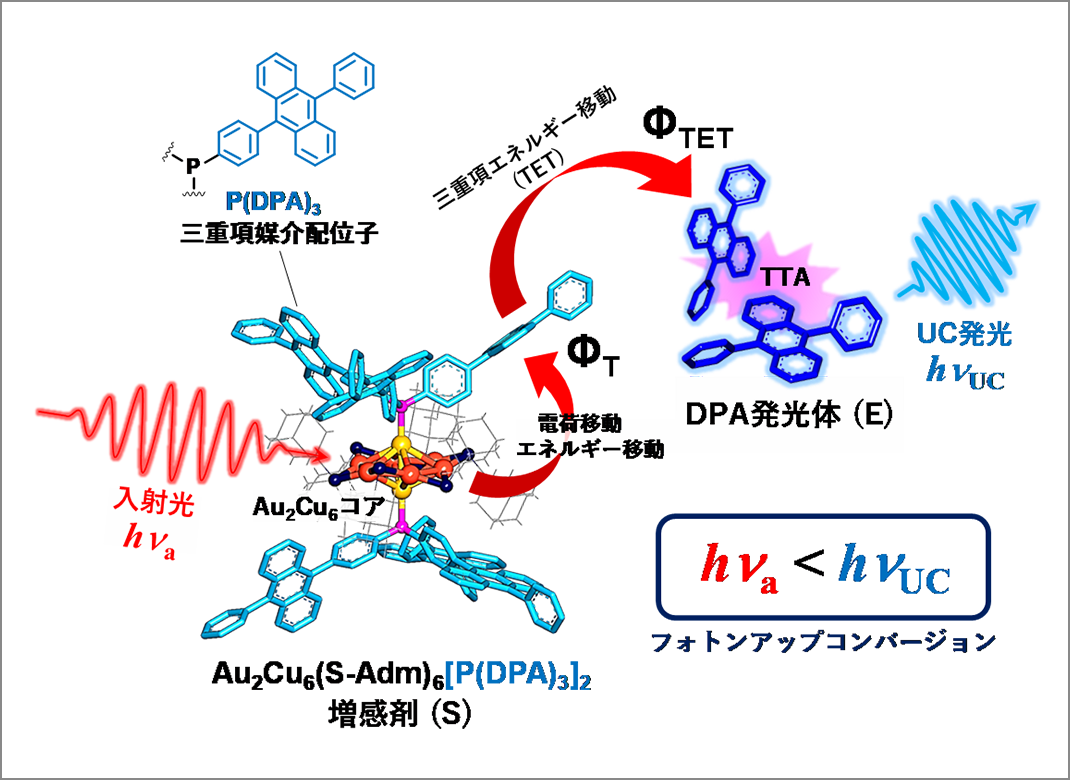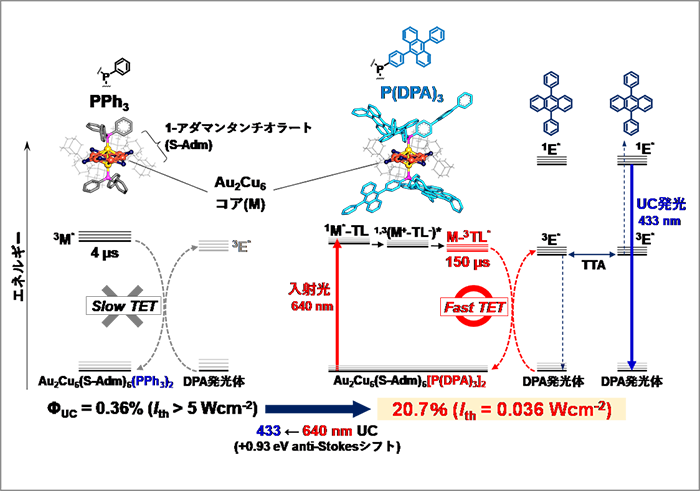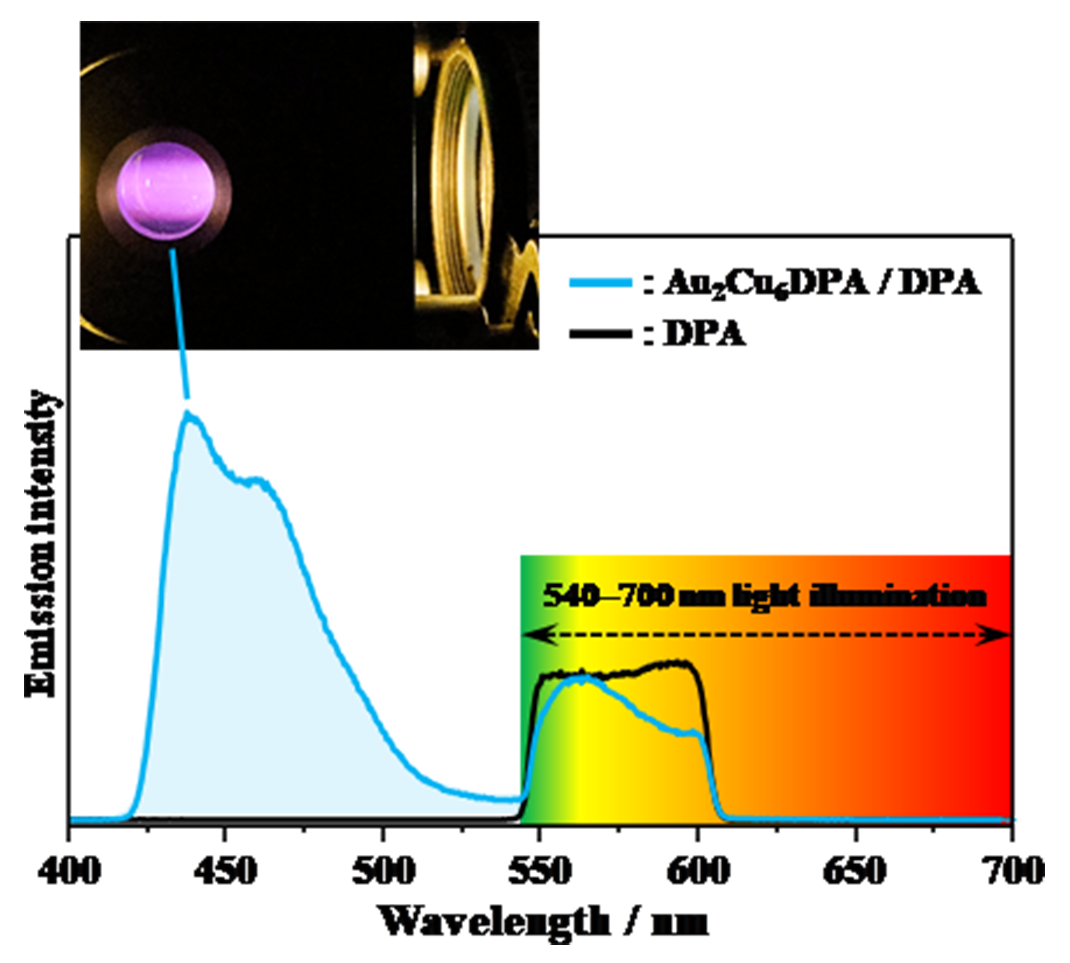Jun 05, 2024
Researchers develop a metal cluster modified with organic ligands capable of retaining light energy, that achieves red-to-blue light upconversion efficiency exceeding 20% under sun illumination
Keyword:RESEARCH
OBJECTIVE.
A research group has succeeded in developing a metal cluster sensitizer, Au2Cu6(S-Adm)6[P(DPA)3]2, in which the Au2Cu6(S-Adm)6 structure is modified with an organic ligand (triplet mediator ligand) capable of retaining light energy it absorbs. The cluster converts red-to-blue light energy (photon upconversion) at an efficiency exceeding 20% under the standard sun illumination of the Earth's surface. This new sensitizer could enable the conversion of low-energy photons from relatively weak light sources such as sunlight or indoor lighting into higher-energy photons at higher efficiencies that are currently possible, which could contribute to the effective utilization of sunlight and other forms of light energy. The research group included Rikkyo University Graduate School of Science doctoral student Daichi Arima (Japan Society for the Promotion of Science DC1 research fellow) and Professor Masaaki Mitsui, as well as Professor Kenji Kobayashi of the Shizuoka University Faculty of Science and others. Their findings were published in the Journal of the American Chemical Society, which is the society’s premier journal, and were featured on a supplementary journal cover for the issue.

Research background
Because the TTA-UC mechanism is a two-photon process based on TTA occurring between 2 emitter molecules, the maximum UC efficiency (ΦUC) is 50%. The key to raising efficiency levels is increasing the sensitizer’s triplet generation quantum yield (ΦT), the TET quantum yield (ΦTET) between the sensitizer and the emitter, and the TTA quantum yield (ΦTTA) of the emitter. In their study, the researchers developed a new sensitizer – Au2Cu6(S-Adm)6[P(DPA)3]2 (S-Adm = 1-adamanthanethiolate; DPA = 9,10-diphenylanthracene) – aimed at achieving 100% ΦT and ΦTET (Figure 1).


Figure 2: Comparison of red-blue upconversion characteristics between Au2Cu6(S-Adm)6(PPh3)2 sensitizer and Au2Cu6(S-Adm)6[P(DPA)3]2 when combined with DPA emitters
The rate constant of the TET process strongly depends on how well the ligands shield the excited triplet state (3M*) of the metal core (M). Au2Cu6(S-Adm)6(PPh3)2 (Figure 2, left) is protected by triphenylphosphine (PPh3) and bulky 1-adamantanethiolate (S-Adm), and exhibits high stability because of the steric and electronic protection granted to the Au2Cu6 core by these ligands. However, this creates a problem, in that it severely limits the intermolecular process which is TET.
In addition, a record-setting level of efficiency for converting red light (640 nm) to blue light (433 nm) with UC was achieved in a degassed solution of Au2Cu6(S-Adm)6[P(DPA)3]2 sensitizers and DPA emitters (E), with ΦUC = 20.7% (threshold intensity Ith = 0.036 Wcm-2). This is a dramatic improvement over Au2Cu6(S-Adm)6(PPh3)2 (ΦUC = 0.36%, Ith > 5 Wcm-2). They also found that the system is capable of 20% conversion efficiency even at the standard level of sunlight illumination (1 sun) seen on the Earth's surface (Figure 3). This demonstrates that modifying the Au2Cu6(S-Adm)6 structure with a triplet mediator ligand P(DPA)3 creates an excellent metal cluster sensitizer that combines excellent photostability with UC efficiency.

Future prospects
Article information
- Title: Triplet-Mediator Ligand-Protected Metal Nanocluster Sensitizers for Photon Upconversion.
- Authors: D. Arima, S. Hidaka, S. Yokomori, Y. Niihori, Y. Negishi, R. Oyaizu, T. Yoshinami, K. Kobayashi,* M. Mitsui*
- Journal name: Journal of the American Chemical Society
DOI: 0.1021/jacs.4c03635
About the project
- JSPS KAKENHI (20K05653 Grant-in-Aid for Scientific Research (C), 24K01614 Grant-in-Aid for Scientific Research (B), Special Research Fellowship 24KJ2066)
- National Institutes of Natural Sciences, Okazaki Research Facilities, Research Center for Computational project: 23-IMS-C221